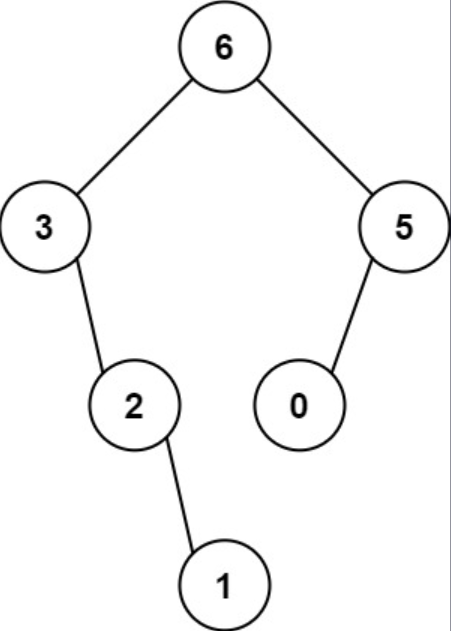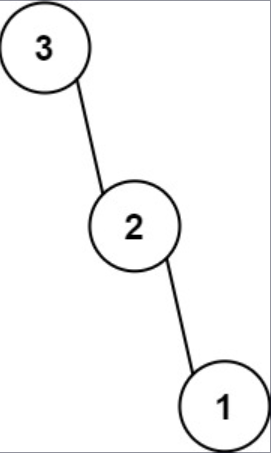2024/1/4大约 5 分钟
一、题目描述
给定一个不重复的整数数组nums。最大二叉树可以用下面的算法从nums递归地构建:
- 创建一个根节点,其值为
nums中的最大值。 - 递归地在最大值左边的子数组前缀上构建左子树。
- 递归地在最大值右边的子数组后缀上构建右子树。
返回nums构建的最大二叉树。
示例 1
输入: nums = [3, 2, 1, 6, 0, 5]
输出: [6, 3, 5, null, 2, 0, null, null, 1]
解释: 递归调用如下所示:
- [3, 2, 1, 6, 0, 5]中的最大值是6,左边部分是[3, 2, 1],右边部分是[0,5]
- [3, 2, 1]中的最大值是3,左边部分是[],右边部分是[2, 1]
- 空数组,无子节点
- [2, 1]中的最大值是2,左边部分是[],右边部分是[1]
- 空数组,无子节点
- 只有一个元素,所以子节点是一个值为1的节点
- [0, 5]中的最大值是5,左边部分是[0],右边部分是[]
- 只有一个元素,所以子节点是一个值为0的节点
- 空数组,无子节点示例 2
输入: nums = [3, 2, 1]
输出: [3, null, 2, null, 1]
提示
1 <= nums.length <= 10000 <= nums[i] <= 1000nums中的所有整数互不相同
相关主题
- 栈
- 树
- 数组
- 分治
- 二叉树
- 单调栈
二、题解
Rust节点定义
#[derive(Debug, PartialEq, Eq)]
pub struct TreeNode {
pub val: i32,
pub left: Option<Rc<RefCell<TreeNode>>>,
pub right: Option<Rc<RefCell<TreeNode>>>,
}
impl TreeNode {
#[inline]
pub fn new(val: i32) -> Self {
TreeNode {
val,
left: None,
right: None,
}
}
}Java节点定义
public class TreeNode {
int val;
TreeNode left;
TreeNode right;
TreeNode() {}
TreeNode(int val) { this.val = val; }
TreeNode(int val, TreeNode left, TreeNode right) {
this.val = val;
this.left = left;
this.right = right;
}
}方法 1: 递归
Rust
pub fn construct_maximum_binary_tree(nums: Vec<i32>) -> Option<Rc<RefCell<TreeNode>>> {
//Self::recur_1(nums)
Self::recur_2(nums)
}
///
/// 时间复杂度: O(n^2)
/// 空间复杂度: O(n)
///
fn recur_1(nums: Vec<i32>) -> Option<Rc<RefCell<TreeNode>>> {
const RECUR: fn(&[i32]) -> Option<Rc<RefCell<TreeNode>>> = |nums| {
let len = nums.len();
if len == 0 {
return None;
}
let (max_idx, max_val) = nums
.iter()
.enumerate()
.max_by(|&(_, a), &(_, b)| a.cmp(b))
.map(|(idx, &val)| (idx, val))
.unwrap_or_default();
let root = Rc::new(RefCell::new(TreeNode::new(max_val)));
if len == 1 {
return Some(root);
}
let (left_nums, right_nums) = (&nums[..max_idx], &nums[max_idx + 1..]);
root.borrow_mut().left = RECUR(left_nums);
root.borrow_mut().right = RECUR(right_nums);
Some(root)
};
RECUR(&nums)
}
///
/// 时间复杂度: O(n^2)
/// 空间复杂度: O(n)
///
fn recur_2(nums: Vec<i32>) -> Option<Rc<RefCell<TreeNode>>> {
const RECUR: fn(&[i32], usize, usize) -> Option<Rc<RefCell<TreeNode>>> =
|nums, l_idx, r_idx| {
let len = r_idx - l_idx;
if len == 0 {
return None;
}
let (max_idx, max_val) = nums[l_idx..r_idx]
.iter()
.enumerate()
.max_by(|&(_, a), &(_, b)| a.cmp(b))
.map(|(idx, val)| (idx + l_idx, *val))
.unwrap_or_default();
let root = Rc::new(RefCell::new(TreeNode::new(max_val)));
if len == 1 {
return Some(root);
}
root.borrow_mut().left = RECUR(nums, l_idx, max_idx);
root.borrow_mut().right = RECUR(nums, max_idx + 1, r_idx);
Some(root)
};
RECUR(&nums, 0, nums.len())
}Java
public TreeNode constructMaximumBinaryTree(int[] nums) {
//return this.recur1(nums);
return this.recur2(nums);
}
Function<List<Integer>, int[]> getMaxAndIdx = nums -> {
int[] res = new int[]{Integer.MIN_VALUE, 0};
for (int i = 0, size = nums.size(); i < size; i++) {
if (nums.get(i) > res[0]) {
res[0] = nums.get(i);
res[1] = i;
}
}
return res;
};
Function<List<Integer>, TreeNode> helper1 = nums -> {
int size = nums.size();
if (size == 0) {
return null;
}
int[] valAndIdx = this.getMaxAndIdx.apply(nums);
int maxVal = valAndIdx[0];
int maxIdx = valAndIdx[1];
TreeNode root = new TreeNode(maxVal);
if (size == 1) {
return root;
}
root.left = this.helper1.apply(nums.subList(0, maxIdx));
root.right = this.helper1.apply(nums.subList(maxIdx + 1, size));
return root;
};
/**
* 时间复杂度: O(n^2)
* 空间复杂度: O(n)
*/
TreeNode recur1(int[] _nums) {
List<Integer> nums = Arrays.stream(_nums).boxed().collect(Collectors.toList());
return this.helper1.apply(nums);
}
@FunctionalInterface
interface TriFunction<A, B, C, D> {
D apply(A a, B b, C c);
}
TriFunction<List<Integer>, Integer, Integer, TreeNode> helper2 = (nums, lIdx, rIdx) -> {
int size = rIdx - lIdx;
if (size == 0) {
return null;
}
int[] valAndIdx = this.getMaxAndIdx.apply(nums.subList(lIdx, rIdx));
int maxVal = valAndIdx[0];
int maxIdx = valAndIdx[1] + lIdx;
TreeNode root = new TreeNode(maxVal);
if (size == 1) {
return root;
}
root.left = this.helper2.apply(nums, lIdx, maxIdx);
root.right = this.helper2.apply(nums, maxIdx + 1, rIdx);
return root;
};
/**
* 时间复杂度: O(n^2)
* 空间复杂度: O(n)
*/
TreeNode recur2(int[] _nums) {
List<Integer> nums = Arrays.stream(_nums).boxed().collect(Collectors.toList());
return this.helper2.apply(nums, 0, _nums.length);
}方法 2: 单调栈
Rust
pub fn construct_maximum_binary_tree(nums: Vec<i32>) -> Option<Rc<RefCell<TreeNode>>> {
//Self::monotonic_stack_1(nums)
Self::monotonic_stack_2(nums)
}
///
/// 时间复杂度: O(n)
/// 空间复杂度: O(n)
///
fn monotonic_stack_1(nums: Vec<i32>) -> Option<Rc<RefCell<TreeNode>>> {
let len = nums.len();
if len == 0 {
return None;
}
let mut stack = Vec::with_capacity(len);
let mut left = vec![usize::MAX; len];
let mut right = vec![usize::MAX; len];
let mut tree = Vec::with_capacity(len);
for i in 0..len {
tree.push(Rc::new(RefCell::new(TreeNode::new(nums[i]))));
while let Some(&last) = stack.last() {
if !(nums[i] > nums[last]) {
break;
}
right[last] = i;
stack.pop();
}
if let Some(&last) = stack.last() {
left[i] = last;
}
stack.push(i);
}
let mut root = None;
for i in 0..len {
if left[i] == usize::MAX && right[i] == usize::MAX {
root = Some(tree[i].clone());
} else if right[i] == usize::MAX
|| (left[i] != usize::MAX && nums[left[i]] < nums[right[i]])
{
tree[left[i]].borrow_mut().right = Some(tree[i].clone());
} else {
tree[right[i]].borrow_mut().left = Some(tree[i].clone());
}
}
root
}
///
/// 时间复杂度: O(n)
/// 空间复杂度: O(n)
///
fn monotonic_stack_2(nums: Vec<i32>) -> Option<Rc<RefCell<TreeNode>>> {
let len = nums.len();
if len == 0 {
return None;
}
let mut stack: Vec<usize> = Vec::with_capacity(len);
let mut tree = Vec::with_capacity(len);
for i in 0..len {
tree.push(Rc::new(RefCell::new(TreeNode::new(nums[i]))));
while let Some(&last) = stack.last() {
if !(nums[i] > nums[last]) {
break;
}
tree[i].borrow_mut().left = Some(tree[last].clone());
stack.pop();
}
if let Some(&last) = stack.last() {
tree[last].borrow_mut().right = Some(tree[i].clone())
}
stack.push(i);
}
Some(tree[stack[0]].clone())
}Java
public TreeNode constructMaximumBinaryTree(int[] nums) {
//return this.monotonicStack1(nums);
return this.monotonicStack2(nums);
}
/**
* 时间复杂度: O(n)
* 空间复杂度: O(n)
*/
TreeNode monotonicStack1(int[] nums) {
int len = nums.length;
if (len == 0) {
return null;
}
Deque<Integer> stack = new ArrayDeque<>(len);
TreeNode[] tree = new TreeNode[len];
int[] left = new int[len];
int[] right = new int[len];
Arrays.fill(left, -1);
Arrays.fill(right, -1);
for (int i = 0; i < len; i++) {
tree[i] = new TreeNode(nums[i]);
while (!stack.isEmpty() && nums[i] > nums[stack.peek()]) {
right[stack.pop()] = i;
}
if (!stack.isEmpty()) {
left[i] = stack.peek();
}
stack.push(i);
}
TreeNode root = null;
for (int i = 0; i < len; i++) {
if (left[i] == -1 && right[i] == -1) {
root = tree[i];
} else if (right[i] == -1 || (left[i] != -1 && nums[left[i]] < nums[right[i]])) {
tree[left[i]].right = tree[i];
} else {
tree[right[i]].left = tree[i];
}
}
return root;
}
/**
* 时间复杂度: O(n)
* 空间复杂度: O(n)
*/
TreeNode monotonicStack2(int[] nums) {
int len = nums.length;
if (len == 0) {
return null;
}
Deque<Integer> stack = new ArrayDeque<>(len);
TreeNode[] tree = new TreeNode[len];
for (int i = 0; i < len; i++) {
tree[i] = new TreeNode(nums[i]);
while (!stack.isEmpty() && nums[i] > nums[stack.peek()]) {
tree[i].left = tree[stack.pop()];
}
if (!stack.isEmpty()) {
tree[stack.peek()].right = tree[i];
}
stack.push(i);
}
// 这里要取栈底的元素
return tree[stack.getLast()];
}